| Pages:
1
2 |
farukturunz
Oud Junkie
    
Posts: 569
Registered: 8-16-2005
Location: Istanbul, Turkey
Member Is Offline
Mood: hopeful
|
|
Quote: Originally posted by FastForward  | Usta Faruk:
I have also noticed that on some of your soundboards, you have used slanted braces around the bridge. You and the Nahhat's have different experiences
and different tonal requisites which is manifested in the variation of your soundboards bracing from the Nahhat. But all is fascinating and
interesting.
---
John:
Very nice and inspiring analysis.
I think the deviation from symmetry is something done on purpose rather than imprecise placement by Nahhat.
|
Dear Fastforward,
You are absolutely right in your statement that deviation from symmetri was done on purpose. This is of course a logical inductive reasoning: A great
master like Nahhat never could have done an imprecise placement accidentally. He must have done it on purpose...If such is the case...shouldn't we ask
"but why?"
His Ouds' fabulous sound Thankfully causes us to think that this deviation may one of the reasons of itself.
Actually we might have reached to a simple implication: As far as the stringing of an instrument can never be symmetrical why would we assume the
instrument to be designed in a way inharmonious with the assymetrical character of the stringing manner?
Violins are explicitly assymetrical, bass bar is placed aligning the bass string (Sol) and the sound post is fit up aligning the treble string (Mi)
Likewise an oud's soundboard must be constructed assymetrically.
Best regards
|
|
|
Edward Powell
Oud Junkie
    
Posts: 1212
Registered: 1-20-2008
Member Is Offline
Mood: g'oud
|
|
Quote: Originally posted by farukturunz  | Quote: Originally posted by FastForward  | Usta Faruk:
I have also noticed that on some of your soundboards, you have used slanted braces around the bridge. You and the Nahhat's have different experiences
and different tonal requisites which is manifested in the variation of your soundboards bracing from the Nahhat. But all is fascinating and
interesting.
---
John:
Very nice and inspiring analysis.
I think the deviation from symmetry is something done on purpose rather than imprecise placement by Nahhat.
|
Dear Fastforward,
You are absolutely right in your statement that deviation from symmetri was done on purpose. This is of course a logical inductive reasoning: A great
master like Nahhat never could have done an imprecise placement accidentally. He must have done it on purpose...If such is the case...shouldn't we ask
"but why?"
His Ouds' fabulous sound Thankfully causes us to think that this deviation may one of the reasons of itself.
Actually we might have reached to a simple implication: As far as the stringing of an instrument can never be symmetrical why would we assume the
instrument to be designed in a way inharmonious with the assymetrical character of the stringing manner?
Violins are explicitly assymetrical, bass bar is placed aligning the bass string (Sol) and the sound post is fit up aligning the treble string (Mi)
Likewise an oud's soundboard must be constructed assymetrically.
Best regards |
My opinion on this is perhaps slightly different...
My feeling is that symmetry is a very very good (perhaps essential) starting point... (can you imagine a speaker cone made in a wildly asymmetric
shape?)
I think soundwaves are helped by a certain amount of symmetry.
BUT the soundboard would only remain perfectly symmetrical if the instrument only had one string.
Obviously because one side of the SB is treble and the other side bass, then some asymmetric changes will be helpful!
I mention all of this because I have experimented a lot with quite wildly asymmetric shapes of instruments and soundboards, and none of them
worked.... it wasn't until I returned to a "more" symmetrical shape that my own experiments started to yield much more positive results.
|
|
|
chaldo
Oud Junkie
    
Posts: 295
Registered: 2-13-2005
Member Is Offline
Mood: archaic mood
|
|
Quote: Originally posted by Danielo  | Hi John,
actually a non-insignificant number of these private owners are on this forum ! I think you don't need persuasion, but rather give some clear protocol
in order to make the measurements accurately without special tools.. I agree it would be very important to have a database of such data.
regards,
Dan |
do we have any other bracing measurements for nahats? what about the database Danielo is proposing?
a call to all of Mike`s oud members who restored/received/analysed nahats.. willing to share the bracing measurements & pattern
chaldo
|
|
|
jdowning
Oud Junkie
    
Posts: 3485
Registered: 8-2-2006
Location: Ontario, Canada
Member Is Offline
Mood: No Mood
|
|
As far I know I am the only forum member to have attempted analysis of the profiles and bracing of old ouds as well as lutes - information posted on
the forum under the topic 'Old Oud compared to Old Lute Geometry'.
Although many forum members may own or have access to old ouds (including Nahats) there has been no response so far to requests for information in a
form that will allow accurate analysis of instrument profiles or bracing geometry - with one recent exception (see Yaron Naor's topic 'Repairing a
'Nahhat' Oud').
For this exercise Yaron provided me with an accurate full size tracing of the oud profile (invert the oud on a large sheet of paper and trace around
the whole profile including the neck. For this exercise the profile of bowl and pegbox are not required). Onto this tracing he then accurately marked
the positions of the braces, nut, bridge, soundhole centre and diameter, neck joint and inside face of the neck block. This assumes of course that the
sound board has been removed - otherwise just a tracing of the profile can provide useful information.
Unfortunately, although better than nothing, working from images is potentially prone to error from optical distortions (perspective view, barrel
distortion etc) unless the photograph is carefully set up and resolution is high enough to accurately determine essential detail.
I analyse the geometry by first placing the drawing on a draughting board and by establishing the vertical and horizontal axes (through the
'symmetrical' centre line of the sound board and through the widest point) The rest is a matter of trial and error using giant sized dividers
(specially made by me from wood) trying to establish conjunct arcs of radii - that are equal to quarter divisions or subdivisions of the maximum sound
board width - to match the oud profile. Oud tradition seems to prefer geometries based upon Pythagorean 3:4:5 right triangles.
I would be happy to undertake and report on the geometrical analysis of any old oud on receipt of a detailed full size drawing prepared as described
above. Otherwise if anyone wants to try their hand at an analysis I would be more than happy to advise further if requested - provided the final
results were to be made available to the world.
|
|
|
FastForward
Oud Junkie
    
Posts: 225
Registered: 6-2-2008
Member Is Offline
Mood: No Mood
|
|
Hi John,
I would love to get a copy of the geometrical analysis/ tracing of the oud/brace locations.
I have traced a Nahhat myself recently and will post the profile. I didn't get the brace locations unfortunately.
Thanks,
Ibrahim...
|
|
|
jdowning
Oud Junkie
    
Posts: 3485
Registered: 8-2-2006
Location: Ontario, Canada
Member Is Offline
Mood: No Mood
|
|
Hi Ibrahim
As there is currently no data base for reference we do not know at this point what bracing geometry or geometries may have been used by the Nahat
luthiers. This may only become evident with the accurate analysis of many full size drawings that provide the exact brace positions relative to a
sound board reference point.
There are two parts to the data collection process that may be treated independantly 1) the external oud profile geometry and 2) the internal brace
geometry so the information that you have to hand may be very useful for adding to the data collection of part 1.
Note that this exercise is to some extent reiterative in that ideas about the geometries may change as more evidence becomes available. So, for
example, I initially thought that the lower sound board profile of some of the Nahat ouds might have been elliptical curves but I now think that both
lower and upper sound board profiles were created in a much simpler fashion from conjunct circular arcs of various radii which can give results very
close to a pure elliptical curve. After all why would a luthier go to all of the trouble of creating an elliptical curve - a complicated point by
point construction - when an almost identical result can be quickly and accurately obtained using just dividers and a straight edge? Simpler is always
better in this respect
|
|
|
FastForward
Oud Junkie
    
Posts: 225
Registered: 6-2-2008
Member Is Offline
Mood: No Mood
|
|
John, check your u2u
|
|
|
jdowning
Oud Junkie
    
Posts: 3485
Registered: 8-2-2006
Location: Ontario, Canada
Member Is Offline
Mood: No Mood
|
|
FastForward has kindly sent me the detailed X-Y coordinates of the oud profile that will form the basis of an analysis of his oud. This is a good
start but I shall need some additional coordinate and other information in order to attempt a complete geometrical analysis of the oud (excluding the
bracing geometry). This will be an interesting project to undertake on this thread to illustrate the level of information required for detailed
analysis and the methodology.
In the meantime it would be of general interest if FastForward could post some more general information about the oud - maker, date of construction,
number of courses, string length etc. together with some images showing the instrument in general view as well as full face, details of the rosette(s)
and bridge details etc
So lets take it from here and see how it goes. Should be interesting
Thanks again Ibrahim for your interest and for investing your valuable time to make this project a possibility.
|
|
|
FastForward
Oud Junkie
    
Posts: 225
Registered: 6-2-2008
Member Is Offline
Mood: No Mood
|
|
I sent you more details.
The oud is a 1921 Nahhat and is not my oud, I only wish!
It has 15 ribs, 6 courses, string length is 60.9cm. The bridge was a typical Nahhat.
I do not have photos with the other requested details.
|
|
|
jdowning
Oud Junkie
    
Posts: 3485
Registered: 8-2-2006
Location: Ontario, Canada
Member Is Offline
Mood: No Mood
|
|
Apologies for the delay in reporting progress but I have been busy with non musical project work while the weather is cooperative so have been trying
to spread my remaining available time around all of my other interests.
I can say that I have undertaken a very preliminary examination of the Nahat oud profile from the coordinates and measurements provided by FastForward
and can confirm that the upper sound board profile appears to almost exactly match a circular arc of 5 basic units radius (4 units = sound board
maximum width) identical to the Nahat upper sound board geometry previously posted on this thread, based upon a Pythagorean 3:4:5 right triangle.
The front edge of the bridge tie block is also located midway between the the maximum width (X axis) of the sound board and the bottom of the
soundboard confirming one of the two possible bridge positions - the other being 3/4 of a basic unit (again based upon a 3:4:5 triangle construction
as shown in the previously posted Nahat construction). The triple sound hole configuration also appears to match a 3:4:5 triangle construction.
A more accurate drawing layout and analysis is now needed to confirm the above.
I also plan to be posting - as time permits - the sound board profile geometry and bracing geometry of a 1936 George Hanna soundboard derived from a
very nice and accurately draughted full size drawing of the original by Yaron Naor. String length measured from the drawing is 60.9 cm.
|
|
|
jdowning
Oud Junkie
    
Posts: 3485
Registered: 8-2-2006
Location: Ontario, Canada
Member Is Offline
Mood: No Mood
|
|
A more detailed construction has now been completed.
It should be mentioned that there is some scope for dimensional error in laying out a geometry directly from a full sized tracing of a soundboard -
compounded when transcribing coordinates measured from a sound board tracing no matter how carefully done. I shall go into more detail later in a
separate topic dealing with measuring and recording sound board measurements. Accumulated dimensional errors (including possible slight variances from
the original intended geometry at the hands of the luthier) might amount at best to ± 0.5 mm but ± 1.0 mm would be more realistic in practice. This
is about the tolerance variation for this project I would estimate.
The attached image is the proposed upper sound board geometry. The geometry is based upon a Pythagorean 3:4:5 right triangle the curve of the
soundboard profile being almost exactly described by a circular arc of radius 35 units with center at point E. The width of the sound board CD is 28
units as is the dimension AB.
The centre of the large sound hole is 10 units from B on the X axis. The diameter of the large sound hole is 9 units. The centre line of the two small
sound holes is 2 units from the X axis however I have yet to discover how the small sound hole diameter (33 mm) relates to that of the large sound
hole. However, the large sound hole diameter locates the inside edges of the small sound holes.
It is interesting to note that 28 is the number of units ('fingers') in the ancient Persian cubit measure of length although in this case the unit
chosen (equal to about 12.25 mm) does not match the ancient finger measure of about 22.8 mm. However - there were also subdivisions of the basic
finger unit (in the Egyptian Royal cubit measurement system at least) - from 1/2, 1/3, 1/4 ....to 1/16 sub units if I remember correctly. I will have
to check further into this but I would not be at all surprised if 12.25 comes out very close to a subdivision of 22.8
Coincidence perhaps?!
Next to describe the lower sound board profile.
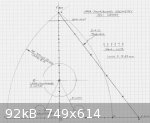
|
|
|
Dr. Oud
Oud Junkie
    
Posts: 1370
Registered: 12-18-2002
Location: Sacramento, CA, USA
Member Is Offline
Mood: better than before
|
|
I believe that analyzing the Nahhat brace pattern based on one example is irrelavant and fruitless. I have measured around a dozen Nahhats. Locations,
sizes, and shapes are all over the place. I find no common denominator, with mean deviations from 15% to 20%. Even trying to find a common constant
that can be applied with a proportional calculation does not work.
Exhaustive studies of the violin master's instruments have resulted in the same inconclusive results. Every Stradivarius violin is different. Great
guitars come in all sizes and shapes. Ouds as well, Nahhat, Manol, Haddad, Georges, whoever. The only valid asumption is that the design varies with
the materials, and since wood is so variable, the variations are endless. This is why factory made instruments are inferior to hand made, built in
fixtures and with machines, they are all the same, and since the material varies, the optimum goal of sound quality is never achieved.
It takes years of building experience to develop a sense of what makes an instrument work, whether oud, violin, guitar or whatever. Why else are the
hand made instruments so much better sounding than the scientifically analyzed, fixture-built ones?
Instrument building is an art, using infinitely variable materials, science cannot solve these mysteries.

|
|
|
jdowning
Oud Junkie
    
Posts: 3485
Registered: 8-2-2006
Location: Ontario, Canada
Member Is Offline
Mood: No Mood
|
|
Well, of course, trying to discover a common geometrical basis for a Nahat bracing pattern based upon only one example is not going to get us very far
but neither is an incomplete list of dimensions taken from 11 ouds made by six members of the Nahat family over a period of 120 years, at least not
without that component essential for a geometrical analysis - a precise, full size tracing of the instrument outline.
The earliest records about the oud confirm that they were then built according to well understood proportions and geometry in accordance with a
universal harmony " in the image of the science of the Creator" according to the musician philosophers of the 10th C 'Bretheren of Purity' (Ikhwan
al-Safa). These early scientific minds also believed in the 'magic' of numbers and their relationship to each other.
If the oud building tradition is an unbroken one then one might expect to find certain fundamental elements in the design of the surviving old ouds -
albeit of very recent history. That is the purpose of my investigative work not only as it applies to ouds but also to determine if there is a common
relationship with early lute geometry - the European lute supposedly having been developed from the oud.
I do not believe that the Nahats or any of the old oud makers developed their designs in a random fashion (reinventing the wheel so to speak) but
followed design concepts dictated by tradition. The precise geometry drawn with only a pair of dividers and a straight edge would be reflected in the
mold and the Nahats may have used several molds of different size but all based upon one (or more) basic geometries. Furthermore, there is scope for
the dimensions of a bowl to deviate from that of the mold at the hands of the maker as well as after the bowl has left the mold awaiting fitting of
the sound board. It is, of course, the shape of the bowl upper face that dictates the final dimensions of the sound board. If the master luthier did
not make the bowl (a less critical task assigned to other workers) he would most likely have selected the material, made and fitted the sound board
and would have made any necessary small corrective adjustments for any deviations from the original design proportions. All these factors might
contribute to dimensional variations in the surviving ouds - assuming of course that they are not fakes and in original condition not otherwise
subject to sound board replacement etc.
However, in order to investigate the situation in depth more than a handful of examples will be required. Under current circumstances that is likely
to be the biggest challenge!
I cannot comment on the geometrical design of 'figure eight' type instruments like the violin and guitar but as these are not related to oud or lute
they are not relevant to this investigation.
I should point out that this current exercise - to examine the geometry of the 1921 Nahhat from dimensions provided by FastForward - does not address
the issue of bracing geometry as no details of the bracing layout have been provided. What the analysis does show, however, is that the geometry of
the sound board has not been created in a random fashion but almost exactly matches a basic geometry that I have found already in both old ouds and
lutes. The upper sound board profile previously posted is based upon the ancient geometry of a Pythagorean 3:4:5 right triangle with the profile
simply described by the arc of a circle.
Likewise - as will be seen next - the lower half of the sound board, location of the bridge etc. is a simple geometrical construction created using
dividers.
No mystery about it at all!
|
|
|
jdowning
Oud Junkie
    
Posts: 3485
Registered: 8-2-2006
Location: Ontario, Canada
Member Is Offline
Mood: No Mood
|
|
The bottom half of the sound board geometry (from the X axis down) is as shown in the attached image. The accuracy against the coordinates given by
FastForward - like the top half is about 1mm or less i.e. an almost perfect match full size.
The geometry is self explanatory. The bottom edge of the sound board F is a distance of half the maximum sound board width from B on the X axis. The
front edge of the bridge tie block is half the distance BF.
The bottom sound board profile (each half) is a combination of three conjunct circular arcs of radius 42 units with centre at A, radius 35 units with
centre at E and radius 12 units centre at 2 units from B on the X and Y axes.
As with all of my proposed geometrical constructions the basic unit is an arbitrary value chosen by the luthier in order to create a design of the
required dimensions.
Next to examine the geometry of a 1936 George Hanna sound board from a full size drawing kindly sent to me by forum member Yaron Naor - this time with
the bracing detail included.
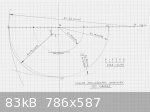
|
|
|
jdowning
Oud Junkie
    
Posts: 3485
Registered: 8-2-2006
Location: Ontario, Canada
Member Is Offline
Mood: No Mood
|
|
I have now completed the geometrical analysis of the full size drawing of the sound board of a 1936 George Hanna Nahhat prepared in meticulous fashion
by Yaron Naor which is complete with bracing.
Perhaps Yaron might provide more detail about the sound board and how it came into his hands - for general information?
For clarity, I shall post the geometrical construction in three steps - the basic layout for the sound board profile, the sound holes diameter, bridge
location and neck block thickness and finally the bracing geometry.
Step 1 is shown in the attached sketch drawn to scale and should be largely self explanatory.
The geometry is based upon three Pythagorean 3:4:5 right triangles with relative dimensions based upon arbitrary 'finger' units. There are 16 units
measuring the maximum width of the sound board with total length AB of 24 units. The upper sound board profile is described by a circular arc of 20
units. The lower sound board profile (8 units deep) has been modified from a semicircle by combining arcs of 6, 20 and 24 units to produce a pseudo
ellipse profile.
The centre C of the large sound hole is 6 units from X at the widest point of the sound board. The horizontal centreline of the two small sound holes
is two units from X. The relative positioning of the three sound holes C, C1 and C2 is given by two 3:4:5 right triangles as shown.
Next - step 2
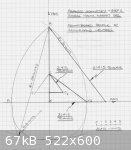
|
|
|
jdowning
Oud Junkie
    
Posts: 3485
Registered: 8-2-2006
Location: Ontario, Canada
Member Is Offline
Mood: No Mood
|
|
I should add that the string length of the oud is 60.9 cm.
The maximum width is 35.4cm (equal to 16 arbitrary units) measured from the soundboard tracing so each 'finger' unit in this case is equal in metric
measure to a value of 22.13 mm (compare this to the ancient Persian standard measure of somewhere between 22.5 and 22.8 mm).
Once upon a time the standard 'finger' measure may literally have been the width of a finger (index finger at the middle joint?) no doubt of some king
- shah or pharoh perhaps. Apparently measures based upon finger width, palm and arm length etc are still used as an approximate measure in the market
places of the Middle East.
It is interesting to speculate, therefore, if some of the Nahhat ouds were custom built to fit the physical dimensions of the hand of a purchaser -
the measure of a finger width being the criterion?
The width of my left hand index finger at the middle joint is about 22 mm and I am comfortable with a lute string length of 60 cm - so perhaps this
oud was originally custom built for a person of close to my stature?
This might account (in part) for some slight size variations found in the surviving Nahhat ouds whereas the geometrical proportions - based upon units
of arbitrary size would remain consistent.
|
|
|
jdowning
Oud Junkie
    
Posts: 3485
Registered: 8-2-2006
Location: Ontario, Canada
Member Is Offline
Mood: No Mood
|
|
The attached image shows the second step giving the front edge of the bridge tie block position, the neck joint position, the depth of the neck block
and the sound hole diameters.
The neck joint N is located at 1 unit from A. The inside face of the neck block is half the distance from N to a point 10 units from X.
The length of the fingerboard (front edge of nut to neck joint) is equal to the distance from the neck joint N to the centre of the large sound hole
C. (Note, however, that in this case the distance from C to the bridge is greater so the 'traditional' proportional division of the string length as
1/3:1/3:1/3 does not quite apply)
The front edge of the bridge tie block is a fifth of the distance NB (23 units) measured from B the bottom of the bowl.
The large soundhole diameter is the distance from the front of the bridge tie block to the horizontal centre line of the small soundholes.
The small soundhole diameter is 1/3 of the large soundhole diameter.
All of these proportions correlate closely to within about a millimeter or less full scale. For example the exact measured diameter of the large
soundhole - as made - is 118 mm and that of the small soundholes 40 mm whereas the measured distance from bridge to small soundhole centreline, taken
from the full size drawing, is 119 mm. Close enough!
Finally, to follow, the bracing geometry
Correction! The distance of the front edge of the bridge tie block should be a fifth of the distance from the neck joint to the bottom of the bowl NB
not AB as shown on the attached sketch
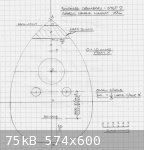
|
|
|
Yaron Naor
Oud Junkie
    
Posts: 275
Registered: 1-24-2009
Location: Bat Hefer, Israel
Member Is Offline
Mood: Happy
|
|
Hi All and John,
This Nahhat oud arrived to me with a new 2years old face made by a luthier here, But the original face was found in the Luthier's shop, so we took it
back and than I could measure everything.
It belongs to a person here in Israel, he bought it from someone years ago.
On the ticket is written "1936 George Hanna Nahhat"
Regards,
Yaron.
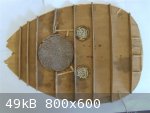
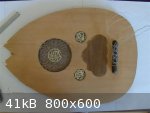
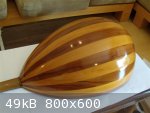
|
|
|
jdowning
Oud Junkie
    
Posts: 3485
Registered: 8-2-2006
Location: Ontario, Canada
Member Is Offline
Mood: No Mood
|
|
The proposed bracing geometry is as shown in the attached sketch.
Brace 6 - is located at the widest part of the sound board (X axis)
Brace 4 - (2 pieces) is located on the horizontal centreline of the large sound hole on each side of the sound hole.
Brace 5 - is located midway between braces 4 and 6.
Brace 3 - is located the same distance from the large sound hole centre C as is brace 5.
Brace 8 - is located midway between the front edge of the bridge tie block and the bottom of the bowl B.
Brace 7 - is located from the front edge of the bridge tie block a distance of 1/4 the distance to brace 6.
Brace 2 - is located at 4/5 NB - the distance from neck joint to bottom of the bowl - measured from B.
Brace 1 - is located the same distance from brace 2 as is
brace 3.
The front edge of the bridge tie block is located at 1/5 NB measured from B.
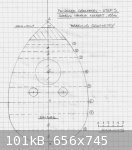
|
|
|
| Pages:
1
2 |